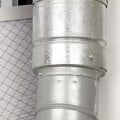HEPA filters have caused controversy due to worries that the tiny fibers they contain could be hazardous to health. However, the latest scientific studies have shown that HEPA filters are safe and have found no evidence of damage.
Ozone
is known to be harmful to health, and certain regulatory bodies have taken action on this issue, banning air purifiers that generate ozone in some places. It is true that these products generate significant amounts of ozone, which can cause long-term damage to olfactory cells and lungs if inhaled.Even more concerning is that symptoms can go away after repeated chronic exposure, making people unaware of the damage being done to their respiratory systems. Even small amounts of ozone can be dangerous; a Canadian study found that measurable bronchial reactivity can occur at ozone concentrations as low as 0.35 parts per million. Ozone can even react with common household cleaners, such as terpenes, which are more commonly known in pine and citrus fragrances, forming formaldehyde, a Group 1 human carcinogen. Ozone can also cause rubber and plastic to deteriorate prematurely in amounts as low as 0.35 parts per million.
Air purifiers do not emit harmful radiation, but only a low-frequency electromagnetic field (EMF) when electrical currents flow. This EMF is safe and the level is comparatively lower than that of a laptop, microwave ovens, cell phones. Most household air purifiers use less than 60 watts of electricity with a 60 Hz and 120 V low-frequency power supply. Some air purifiers, under appropriate conditions, can effectively remove certain respirable size particles (e.g., tobacco smoke particles).
These invisible particles are a cause for concern because they can be inhaled deep into the lungs. Removing these particles can reduce the health-related effects of exposed individuals; these effects can range from eye and lung irritation to more serious effects, such as cancer and decreased lung function. Another problem with these ionizers is that they can produce ozone, “and this is very bad in an indoor environment” according to Dr. James Sublett, former clinical professor and head of allergy and immunology at the University of Louisville.
Ozone is a type of oxygen molecule produced by electrostatic reactions; although it naturally exists in the air we breathe, its concentrations tend to be very low. At higher concentrations, it can damage lungs and respiratory tissue. An air purifier cannot make you sick since it is a simple device designed to clean the air of harmful particles. While industrial air filtration units, including HEPA filters and gas phase filters, can be useful for keeping indoor air pollutant levels low in chemical facilities, they are not sufficient to ensure the safety of laboratory workers on their own. One of the most popular air purifiers you may have heard of are those that use “HEPA” filters; a mechanical air purifier uses an internal fan to draw air through a series of filters, trapping harmful particles before returning clean air to the room. There are also a few types of these, including HVAC filters, portable air purifiers, and ceiling mounted air purifiers. Do all of that, and a portable air purifier is worth buying, especially for people with allergies or asthma, people at risk for cardiovascular disease, and families with young children.
A carbon filter is the most suitable unit for cleaning gaseous VOCs from the air; for example when new furniture is released from gases. The American Lung Association also recommends purchasing air purifiers for families suffering from allergies, asthma and other sensitivities. If your home doesn't have a forced air system or if you're looking for something for your workplace, both Sublett and Edwards recommend a portable air purifier that has a built-in replaceable HEPA filter. For an air ionizer to work and be truly effective studies indicate that a truly strong ionizer is needed to thoroughly eliminate those annoying contaminants. Commercial air cleaners and industrial air filtration units will help protect the health of chemical laboratory workers by limiting their exposure to toxic chemical waste. For example if the air is in the presence of light for a quarter of a second you'll need a 26400 microwatt UV bulb. Industrial air filtration and ventilation will reduce the level of hazardous chemicals in the air either by trapping chemical particles in commercial air filters or by reducing their concentration by exchanging indoor air with outdoor air. Even so you should consider having an air purifier with a HEPA filter in your home since although its ability to hinder the transmission of coronavirus has not been proven it can be useful in some situations.
But because HEPA air purifiers don't mask odors in the same way as ozone generators you might want to see one that combines the HEPA filter with activated carbon that traps gases and chemicals that your HEPA filter can't trap.



